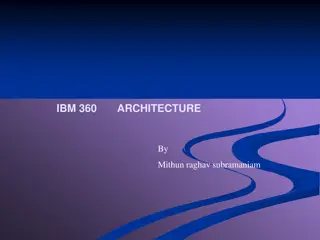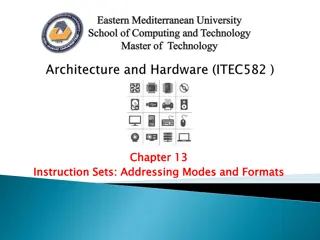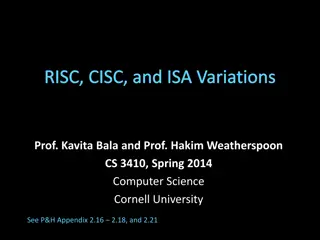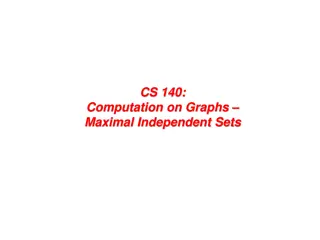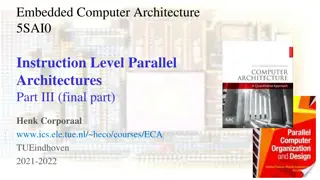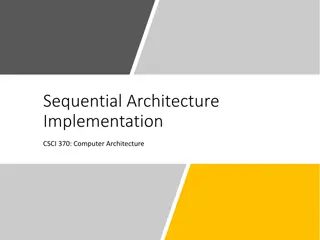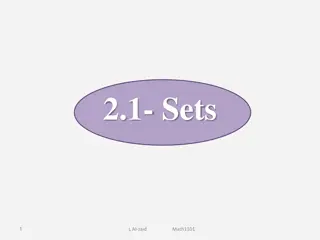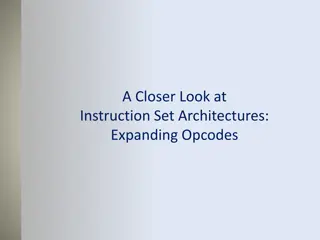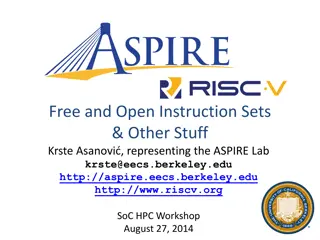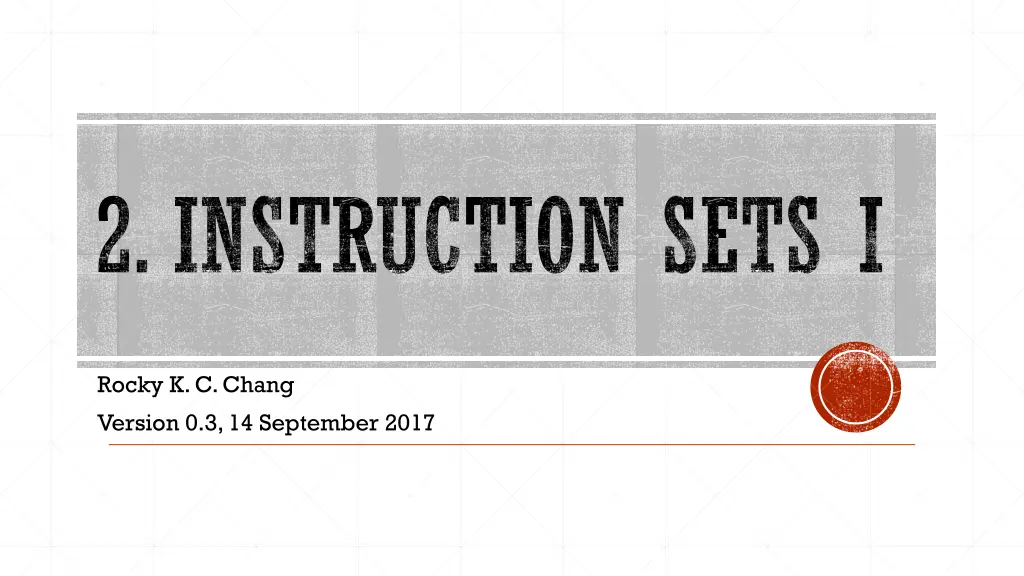
Understanding MIPS Architecture and Instruction Sets
Explore the fundamentals of MIPS architecture and instruction sets, including writing MIPS assembly language, arithmetic and logical operations, data transfer, control flow, and byte order concepts. Learn about the evolution of instruction set architectures, the RISC philosophy, and the simplicity and elegance of the MIPS architecture. Dive into the world of MIPS32-bit instructions and the significance of MIPS in embedded applications.
Download Presentation

Please find below an Image/Link to download the presentation.
The content on the website is provided AS IS for your information and personal use only. It may not be sold, licensed, or shared on other websites without obtaining consent from the author. If you encounter any issues during the download, it is possible that the publisher has removed the file from their server.
You are allowed to download the files provided on this website for personal or commercial use, subject to the condition that they are used lawfully. All files are the property of their respective owners.
The content on the website is provided AS IS for your information and personal use only. It may not be sold, licensed, or shared on other websites without obtaining consent from the author.
E N D
Presentation Transcript
2. INSTRUCTION SETS I Rocky K. C. Chang Version 0.3, 14 September 2017
GOALS OF THIS LECTURE Know how to write MIPS assembly language for Arithmetic operations Logical operations Data transfer between registers and memory Control flow (branching and loops) Understand two different types of byte order 2
LEVELS OF REPRESENTATION/INTERPRETATION temp = v[k]; v[k] = v[k+1]; v[k+1] = temp; High Level Language Program (e.g., C) Compiler lw $t0, 0($2) lw $t1, 4($2) sw $t1, 0($2) sw $t0, 4($2) Anything can be represented Assembly Language Program (e.g., MIPS) as a number, i.e., data or instructions Assembler 0000 1001 1100 0110 1010 1111 0101 1000 1010 1111 0101 1000 0000 1001 1100 0110 1100 0110 1010 1111 0101 1000 0000 1001 0101 1000 0000 1001 1100 0110 1010 1111 Machine Language Program (MIPS) Machine Interpretation Hardware Architecture Description (e.g., block diagrams) Architecture Implementation Logic Circuit Description (Circuit Schematic Diagrams) 3 3
ASSEMBLY LANGUAGE Basic job of a CPU: execute lots of instructions. Instructions are the primitive operations that the CPU may execute. Different CPUs implement different sets of instructions. The set of instructions a particular CPU implements is an Instruction Set Architecture (ISA). Examples: ARM, Intel x86, MIPS, RISC-V, IBM/Motorola PowerPC (old Mac), Intel IA64, ... 4
INSTRUCTION SET ARCHITECTURES Early trend was to add more and more instructions to new CPUs to do elaborate operations VAX architecture had an instruction to multiply polynomials! RISC philosophy (Cocke IBM, Patterson, Hennessy, 1980s) Reduced Instruction Set Computing Keep the instruction set small and simple, makes it easier to build fast hardware. Let software do complicated operations by composing simpler ones. 5
MIPS ARCHITECTURE MIPS semiconductor company that built one of the first commercial RISC architectures We will study the MIPS architecture in some detail in this class. Why MIPS instead of Intel x86? MIPS is simple, elegant. Don t want to get bogged down in gritty details. MIPS widely used in embedded apps, x86 little used in embedded, and more embedded computers than PCs 6
MIPS32 (32-BIT INSTRUCTIONS) Memory Program Bytes 7 One MIPS Instruction = 32 bits Data 7
HOW PROGRAM IS EXECUTED? Memory Processor Read Instructio n Bits Control Program Datapath Bytes Instruction Address Program Counter Registers Data Arithmetic & Logic Unit (ALU) The program counter (internal register inside processor) holds address of next instruction to be executed 8
ASSEMBLY VARIABLES: REGISTERS Unlike HLL like C or Java, assembly cannot use variables Why not? Keep hardware simple Assembly operands are registers. Limited number of special locations built directly into the hardware Operations can only be performed on these registers! Benefit: Since registers are directly in hardware, they are very fast (faster than 1 ns - light travels 30cm in 1 ns!!! ) 9
NUMBER OF MIPS REGISTERS Drawback: Since registers are in hardware, there are a predetermined number of them. Solution: MIPS code must be very carefully put together to efficiently use registers. 32 registers in MIPS Why 32? Smaller is faster, but too small is bad. Goldilocks problem. Each MIPS register is 32 bits wide Groups of 32 bits called a word in MIPS 10
NAMES OF MIPS REGISTERS Registers are numbered from 0 to 31 Each register can be referred to by number or name. Number references: $0, $1, $2, $30, $31 For now: $16 - $23 $s0 - $s7(correspond to saved variables) $8 - $15 $t0 - $t7(correspond to temporary variables) Later will explain other 16 register names In general, use names to make your code more readable 11
C, JAVA VARIABLES VS. REGISTERS In C (and most High Level Languages) variables declared first and given a type Example: int fahr, celsius; char a, b, c, d, e; Each variable can ONLY represent a value of the type it was declared as (cannot mix and match int and char variables). In Assembly Language, registers have no type; operation determines how register contents are treated. 12
ADDITION AND SUBTRACTION INSTRUCTIONS 13
ADDITION AND SUBTRACTION OF INTEGERS Addition in Assembly Example: add $s0,$s1,$s2 (in MIPS) Equivalent to: a = b + c (in C) where C variables MIPS registers are: a $s0, b $s1, c $s2 Subtraction in Assembly Example: sub $s3,$s4,$s5 (in MIPS) Equivalent to: d = e - f (in C) where C variables MIPS registers are: d $s3, e $s4, f $s5 14
ADDITION AND SUBTRACTION OF INTEGERS (CONTD) How to translate the following C statement? a = b + c + d - e; Break into multiple instructions: add $t0, $s1, $s2 # temp = b + c add $t0, $t0, $s3 # temp = temp + d sub $s0, $t0, $s4 # a = temp - e A single C statement may break up into several lines of MIPS. Notice the use of temporary registers don t want to modify the saved variable registers $s. Everything after the hash mark on each line is ignored (comments) 15
IMMEDIATE OPERANDS Immediates are numerical constants. They appear often in code, so there are special instructions for them. Otherwise, need more instructions to fetch them from the memory. Add Immediate: addi $s0,$s1,-10 (in MIPS) f = g - 10 (in C) where MIPS registers $s0,$s1 are associated with C variables f, g. Syntax similar to add instruction, except that last argument is a number instead of a register. No subtract immediate instruction 16
THE CONSTANT ZERO MIPS register 0 ($zero) is the constant 0 Cannot be overwritten Useful for common operations E.g., move between registers add $t2, $s1, $zero 17
OVERFLOW ARITHMETIC Recall: Overflow occurs when there is a mistake in arithmetic due to the limited precision in computers. Example (4-bit unsigned numbers): 15 1111 + 3 + 0011 18 10010 But we don t have room for 5-bit solution, so the solution would be 0010, which is +2, and wrong . 18
OVERFLOW HANDLING IN MIPS Some languages detect overflow (Ada), some don t (most C implementations) MIPS solution is 2 kinds of arithmetic instructions: These cause overflow to be detected add (add) add immediate (addi) subtract (sub) These do not cause overflow detection add unsigned (addu) add immediate unsigned (addiu) subtract unsigned (subu) Compiler selects appropriate arithmetic MIPS C compilers produce addu, addiu, subu 19
INSTRUCTIONS FOR DATA TRANSFER BETWEEN REGISTERS AND MEMORY Memory Processor Input Enable? Read/Write Control Program Datapath Address Write Data = Store to memory Bytes PC Registers Data Read Data = Load from memory Arithmetic & Logic Unit (ALU) Output Processor-Memory Interface I/O-Memory Interfaces 20 Source: Slides by K. Asanovic & V. Stojanovic for CS61C at UC/Berlekey
BYTE ADDRESSING Lots of data is smaller than 32 bits, but rarely smaller than 8 bits works fine if everything is a multiple of 8 bits 8 bit chunk is called a byte (1 word = 4 bytes) Memory addresses are really in bytes, not words Word addresses are 4 bytes apart. Word address is same as address of leftmost byte. Byte order Addr of lowest byte in word is addr of word 12 13 14 15 3 8 9 10 11 2 4 5 6 7 1 0 1 2 3 0 21
BYTE ORDER Problem: What order do we read numbers (and other data types) that occupy more than one byte? Example: 12345678hex It can be stored in 4 x 8bit locations as follows. Address Order (1) Order (2) 184 12 78 185 34 56 186 56 34 187 78 12 22
ENDIANNESS The problem is called Endianness. The system on the left (read top down) has the least significant byte in the highest address This is called Big-endian. The system on the right (read bottom up) has the least significant byte in the lowest address This is called Little-endian. Little-endian: e.g., Intel 80x86, x86, VAX, Alpha Big-endian; e.g., IBM System 370/390, the Motorola 680x0, Sun SPARC, and most RISC machines. 23
EXAMPLE OF C DATA STRUCTURE 1 word = 4 byte 24 Source: Stallings,Computer organization and architecture:Designing for performance, 9th edition, Prentice Hall, 2013.
ALTERNATIVE VIEW OF C PROG. EXAMPLE 25 Source: Stallings,Computer organization and architecture:Designing for performance, 9th edition, Prentice Hall, 2013.
TRANSFER FROM MEMORY TO REGISTER C code Using Load Word (lw) in MIPS: lw $t0,12($s3) # Temp reg $t0 gets A[3] add $s1,$s2,$t0 # g = h + A[3] Note: $s3 base register (containing the starting address of A) 12 offset in bytes Offset must be a constant known at assembly time. int A[100]; g = h + A[3]; 26
TRANSFER FROM REGISTER TO MEMORY C code int A[100]; A[10] = h + A[3]; Using Store Word (sw) in MIPS: lw $t0,12($s3) # Temp reg $t0 gets A[3] add $t0,$s2,$t0 # Temp reg $t0 gets h + A[3] sw $t0, 40($s3) # A[10] = h + A[3] Note: $s3 base register (containing the starting address of A) 12,40 offsets in bytes 27
LOADING AND STORING BYTES Transferring a byte between a register and the memory. lb (load byte) and sb (store byte) Same format as lw, sw E.g., lb $s0, 3($s1): load a byte from the memory address of (3 + the content of $s1) to the low byte position of register $s0. Signed and unsigned load byte lbu (unsigned lb): filling in the rest with 0 E.g., loading 10000001 00000000 00000000 00000000 10000001 E.g., loading 01000001 00000000 00000000 00000000 01000001 lb (signed lb): filling in the rest with the sign bit (sign extension) E.g., loading 10000001 11111111 11111111 11111111 10000001 E.g., loading 01000001 00000000 00000000 00000000 01000001 28
SPEED OF REGISTERS VS. MEMORY Given that Registers: 32 words (128 bytes) Memory: Billions of bytes (2 GB to 8 GB on laptop) and the RISC principle is Smaller is faster How much faster are registers than memory? About 100-500 times faster in terms of latencyof one access! 29
REVIEW QUESTION Assume that the base address of array A[] is in $s3, and the value of h is in $s2. Compile the following C statement into MIPS assembly. A[16] = h + A[8]; 30
REVIEW QUESTION We want to translate *x = *y +1 into MIPS (x, y pointers stored in: $s0 and $s1). Which one is correct? A: addi $s0,$s1,1 B: lw $s0,1($s1) sw $s1,0($s0) C: lw $t0,0($s1) addi $t0,$t0,1 sw $t0,0($s0) D: sw $t0,0($s1) addi $t0,$t0,1 lw $t0,0($s0) E: lw $s0,1($t0) sw $s1,0($t0) 31
MIPS LOGICAL INSTRUCTIONS Useful to operate on fields of bits within a word e.g., characters within a word (8 bits) Operations to pack /unpack bits into words Called logical operations C Java operators & | ~ << >>> Logical operations Bit-by-bit AND Bit-by-bit OR Bit-by-bit NOT Shift left Shift right operators & | ~ << >> MIPS instructions and or not sll srl 33
LOGIC SHIFTING Shift Left: sll $s1,$s2,2#s1=s2<<2 Store in $s1 the value from $s2 shifted 2 bits to the left (they fall off end), inserting 0 s on right Before: 0000 0002hex 0000 0000 0000 0000 0000 0000 0000 0010two After: 0000 0008hex 0000 0000 0000 0000 0000 0000 0000 1000two What arithmetic effect does shift left have? Shift Right: srl is opposite shift; >> What arithmetic effect does shift right have? 34
ARITHMETIC SHIFTING Shift right arithmetic moves n bits to the right (insert high order sign bit into empty bits) For example, if register $s0 contains 1111 1111 1111 1111 1111 1111 1110 0111two= -25ten If executed sra $s0, $s0, 4, result is: 1111 1111 1111 1111 1111 1111 1111 1110two= -2ten Unfortunately, this is NOT same as dividing by 2n Fails for odd negative numbers C arithmetic semantics is that division should round towards 0 35
AND OPERATIONS Useful to mask bits in a word Select some bits, clear others to 0 and $t0, $t1, $t2 $t2 0000 0000 0000 0000 0000 1101 1100 0000 $t1 0000 0000 0000 0000 0011 1100 0000 0000 $t0 0000 0000 0000 0000 0000 1100 0000 0000 36
OR OPERATIONS Useful to include bits in a word Set some bits to 1, leave others unchanged or $t0, $t1, $t2 $t2 0000 0000 0000 0000 0000 1101 1100 0000 $t1 0000 0000 0000 0000 0011 1100 0000 0000 $t0 0000 0000 0000 0000 0011 1101 1100 0000 37
NOT OPERATIONS Useful to invert bits in a word Change 0 to 1, and 1 to 0 In keeping with the three-operand format, include the instruction NOR(NOT OR) instead of NOT. If one operand is zero, it is equivalent to NOT: A NOR 0 = NOT (A OR 0) = NOT (A). nor $t0, $t1, $zero $t1 0000 0000 0000 0000 0011 1100 0000 0000 $t0 1111 1111 1111 1111 1100 0011 1111 1111 38
REVIEW QUESTION Assume the following register contents: $t0 = 0xAAAAAAAA, $t1 = 0x12345678. For the register values shown above, what is the value of $t2 for the following sequence of instructions? sll $t2, $t0, 4 andi $t2, $t2, 1 39
TYPES OF BRANCHES Conditional Branch change control flow depending on outcome of comparison MIPS instructions: branch if equal (beq) or branch if notequal (bne) beq register1,register2,L1 means: go to statement labeled L1 if (value in register1) == (value in register2) otherwise, go to the next statement Unconditional Branch always branch MIPS instruction: jump (j) 41
IF STATEMENT EXAMPLE Assuming translations below, compile if block $s0 f $s1 g $s2 h $s3 i $s4 j if (i == j) f = g + h; May need to negate branch condition. Exit: bne $s3,$s4,Exit add $s0,$s1,$s2 42
IF-ELSE STATEMENT EXAMPLE Assuming translations below, compile $s0 f $s1 g $s2 h $s3 i $s4 j if (i == j) f = g + h; else f = g h; Else: Exit: bne $s3,$s4,Else add $s0,$s1,$s2 j Exit sub $s0,$s1,$s2 43
INEQUALITIES IN MIPS General programs need to test < and > as well. MIPS Inequality Instruction: Set on Less Than Syntax:slt reg1, reg2, reg3 Meaning: if (reg2 < reg3) reg1 = 1; else reg1 = 0; set means change to 1 , reset means change to 0 . 44
INEQUALITIES IN MIPS (CONTD) How do we use this? Compile by hand: if (g < h) goto Less; #g:$s0, h:$s1 Answer: compiled MIPS code slt $t0,$s0,$s1 # $t0 = 1 if g<h bne $t0,$zero,Less # if $t0!=0 goto Less Register $zero always contains the value 0, so bne and beq often use it for comparison after an slt instruction. sltutreats registers as unsigned. 45
IMMEDIATES IN INEQUALITIES slti an immediate version of sltto test against constants Loop: . . . beq $t0,$zero,Loop # goto Loop slti $t0,$s0,1 # $t0 = 1 if # $s0<1 # if $t0==0 # (if ($s0>=1)) 46
LOOPS IN C/ASSEMBLY Simple loop in C; A[] is an array of int do { g = g + A[i]; i = i + j; } while (i != h); Use this mapping: g, h, i, j, &A[0] $s1, $s2, $s3, $s4, $s5 Loop: sll $t1,$s3,2 # $t1= 4*i addu $t1,$t1,$s5 # $t1=addr A+4i lw $t1,0($t1) # $t1=A[i] add $s1,$s1,$t1 # g=g+A[i] addu $s3,$s3,$s4 # i=i+j bne $s3,$s2,Loop # goto Loop # if i!=h 47
REVIEW QUESTION Assume $t0 holds the value 0x00101000. What is the value of $t2 after the following instructions? slt $t2, $0, $t0 bne $t2, $0, ELSE j DONE ELSE: addi $t2, $t2, 2 DONE: 48
REVIEW QUESTION Consider the following MIPS loop: LOOP: slt $t2, $0, $t1 beq $t2, $0, DONE subi $t1, $t1, 1 addi $s2, $s2, 2 j LOOP DONE: Assume that the register $t1 is initialized to the value 10. What is the value in register $s2 assuming $s2 is initially zero? 49
CONCLUSION Computer words and vocabulary are called instructions and instruction set respectively. MIPS is example RISC instruction set in this class. Rigid format: 1 operation, 2 source operands, 1 destination add,sub,mul,div,and,or,sll,srl,sra lw,sw,lb,sb to move data to/from registers from/to memory beq, bne, j, slt, slti for decision/flow control Simple mappings from arithmetic expressions, array access, if-then- else in C to MIPS instructions 50

